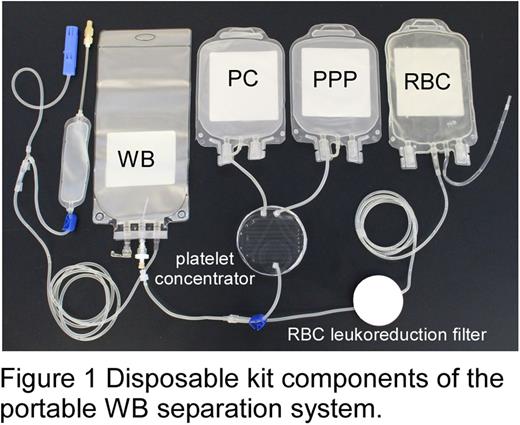Abstract
Introduction: Centrifugation is the cornerstone of blood processing because it has been the only technology capable of separating large volumes of whole blood (WB) into components for storage under optimal conditions in a reasonable amount of time. However, the logistical complications and potential cellular damage associated with centrifugation-based manufacturing of blood products are well documented. In this study, we present a new dual-stage, passive separation system for processing WB into components, which does not require costly or complex machinery, and can be used on-site by minimally-trained personnel immediately following blood donation. This approach consists of two passive blood-processing modules, neither of which requires electricity: (i) a blood-bag compression apparatus designed to maximize the speed and efficiency of passive RBC sedimentation for separating RBCs and platelet-rich plasma (PRP) from WB at normal gravity (i.e. 1×g), and (ii) a flow-through microfluidic concentrator for continuous high-throughput enrichment of platelets from the PRP fraction, to produce platelet concentrate (PC) and platelet-poor plasma (PPP). The ability of this technology to produce high-quality blood components quickly without the use of a centrifuge was demonstrated.
Materials and Methods: Freshly-donated units (~500mL) of whole blood (WB) were randomly selected (under an IRB approved protocol) from blood donations by healthy donors who met AABB/FDA eligibility criteria. The WB units (n = 6) were divided into two equal parts, with one half processed by the conventional centrifugation technique ('PRP method,' control arm), and the other half with our new portable blood separation system (test arm). Both separation procedures were performed concurrently, within 4 hours of donation. The initial quality of blood products (RBCs, platelets and plasma) generated by the two approaches were compared using an extensive panel of hematological parameters, including hematocrit, mean corpuscular volume, platelet count, mean platelet volume, white blood cell count, RBC and platelet phosphatidylserine (PS) exposure, platelet P-selectin expression, total free protein, free hemoglobin (Hb), % hemolysis, RBC deformability, pH, K+, Na+, glucose, lactate, ATP, 2,3-diphosphoglyceric acid concentration (2,3-DPG), platelet aggregability (agonists: thrombin receptor agonist peptide, adenosine diphosphate, collagen), factors VIII and XI, soluble CD40-ligand (sCD40L), and thromboxane B2 (TxB2).
Results and Discussion: To perform separation using our new portable separation system, 250mL ('half-unit') of WB was placed in a 1L sedimentation bag between two plates of a custom-made compression apparatus at a slight incline (~10°) to allow natural sedimentation of WB into PRP and RBCs at unit gravity. After 150 minutes of sedimentation, the supernatant PRP was expressed from the sedimentation bag through the high-throughput microfluidic platelet concentrator at ~3.2 mL/min to process PRP into PC and PPP. Following PRP expression, the sedimented RBCs were mixed with AS-3 and leukoreduced in the same manner as RBCs produced via centrifugation. The entire separation process for a half-unit of WB was completed within ~3 hours. Comparison of nearly all RBC parameters showed no significant differences between the two separation approaches, although the portable system generated RBC units with a slight, statistically significant improvement in 2,3-DPG (portable system: 15.8 ± 1.2 µmol/g of Hb; centrifugation: 15.3 ± 1.2 µmol/g of Hb; p < 0.05). Importantly, key markers of platelet damage were significantly and meaningfully reduced in PC units generated using the portable, centrifuge-free system: platelet activation (assessed via P-selectin expression) was less than half of that for PC units produced via centrifugation (portable system: 5.2 ± 2.1%; centrifugation: 12.2 ± 3.6%; p < 0.01), and the release of pro-inflammatory mediators (sCD40L, TxB2) was also significantly lower in PC units produced with the portable system than via centrifugation (p < 0.01).
Conclusion: This study demonstrated that a simple, portable, passive system for separating donated blood into components could be a viable alternative to centrifugation - particularly for applications in remote or resource-limited settings, or for patients requiring highly functional and undamaged platelets.
Gifford: Halcyon Biomedical Incorporated: Employment, Equity Ownership. Shevkoplyas: New Health Sciences, Inc.: Consultancy, Research Funding; Halcyon Biomedical Incorporated: Employment, Equity Ownership, Patents & Royalties: U.S. Patent Appl. 61/929,357, Research Funding.
Author notes
Asterisk with author names denotes non-ASH members.


This feature is available to Subscribers Only
Sign In or Create an Account Close Modal